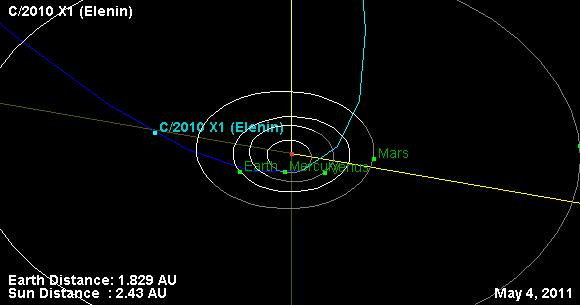Wimpy Comet Elenin Headed for Inner Solar System

A comet first discovered just six months ago will be making a visit to the inner solar system soon, but don't expect to be completely dazzled. This comet is a bit of a wimp, NASA says.
Comet Elenin (also known by its astronomical name C/2010 X1), was first detected on Dec. 10, 2010 by Leonid Elenin, an observer in Lyubertsy, Russia, who found the comet while using the remote-controlled ISON-NM observatory near Mayhill, New Mexico.
At the time of its discovery, the comet was about 401 million miles (647 million kilometers) from Earth. Over the past 4 1/2 months, the comet has closed the distance to Earth's vicinity as it makes its way closer to perihelion (its closest point to the sun). [See Comet Elenin's Path Through Solar System]
As of May 4, Comet Elenin's distance is about 170 million miles (274 million km).
"That is what happens with these long-period comets that come in from way outside our planetary system," said Don Yeomans of NASA's Near-Earth Object Program Office at NASA's Jet Propulsion Laboratory in Pasadena, Calif., in a statement. "They make these long, majestic, speedy arcs through our solar system, and sometimes they put on a great show. But not Elenin. Right now that comet looks kind of wimpy."
The comet doesn't offer much of a view and is quite dim to behold. [Video: Where Comets Come From]
"We're talking about how a comet looks as it safely flies past us," said Yeomans. "Some cometary visitors arriving from beyond the planetary region — like Hale-Bopp in 1997 — have really lit up the night sky where you can see them easily with the naked eye as they safely transit the inner-solar system. But Elenin is trending toward the other end of the spectrum. You'll probably need a good pair of binoculars, clear skies, and a dark, secluded location to see it even on its brightest night."
Get the Space.com Newsletter
Breaking space news, the latest updates on rocket launches, skywatching events and more!
Comet Elenin, an icy run
Comet Elenin should be at its brightest shortly before the time of its closest approach to Earth on Oct. 16 of this year. At its closest point, it will be 22 million miles (35 million km) from us.
Even at such a distance, the comet will not be able to shift tides or tectonic plates here on Earth, as some internet rumors have suggested. Some have even wondered if the comet could possibly be pushed closer to Earth than usual.
"Comet Elenin will not encounter any dark bodies that could perturb its orbit, nor will it influence us in any way here on Earth," said Yeomans. "It will get no closer to Earth than 35 million kilometers."
Not only is Elenin far away, but it is also on the small side for comets, said Yeomans. [Photos of Halley's Comet Through History]
"So you've got a modest-sized icy dirtball that is getting no closer than 35 million kilometers," said Yeomans. "It will have an immeasurably miniscule influence on our planet. By comparison, my subcompact automobile exerts a greater influence on the ocean's tides than comet Elenin ever will."
Fall's cosmic comet show
But just because the comet won't change much here on Earth doesn't mean skywatchers shouldn't pay attention.
"This comet may not put on a great show. Just as certainly, it will not cause any disruptions here on Earth. But there is a cause to marvel," said Yeomans. "This intrepid little traveler will offer astronomers a chance to study a relatively young comet that came here from well beyond our solar system's planetary region. After a short while, it will be headed back out again, and we will not see or hear from Elenin for thousands of years. That's pretty cool."
NASA detects, tracks and characterizes asteroids and comets passing relatively close to Earth using both ground- and space-based telescopes.
The agency's Near-Earth Object Observations Program, commonly called "Spaceguard," discovers these objects, characterizes a subset of them, and predicts their paths to determine if any could be potentially hazardous to our planet.
Follow SPACE.com for the latest in space science and exploration news on Twitter @Spacedotcom and on Facebook.
Join our Space Forums to keep talking space on the latest missions, night sky and more! And if you have a news tip, correction or comment, let us know at: community@space.com.

Space.com is the premier source of space exploration, innovation and astronomy news, chronicling (and celebrating) humanity's ongoing expansion across the final frontier. Originally founded in 1999, Space.com is, and always has been, the passion of writers and editors who are space fans and also trained journalists. Our current news team consists of Editor-in-Chief Tariq Malik; Editor Hanneke Weitering, Senior Space Writer Mike Wall; Senior Writer Meghan Bartels; Senior Writer Chelsea Gohd, Senior Writer Tereza Pultarova and Staff Writer Alexander Cox, focusing on e-commerce. Senior Producer Steve Spaleta oversees our space videos, with Diana Whitcroft as our Social Media Editor.









